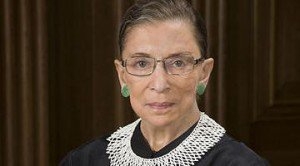 Ruth Bader Ginsburg (or “Notorious RBG” as she is affectionately known as in the law blogging world) was born in Brooklyn, New York, on March 15, 1933. Although Ginsburg has a lengthy list of accomplishments earning her the “notorious” moniker, one of her most notable accomplishments includes being only the second female United States Supreme Court Justice. Ginsburg is widely considered to be a feminist figure, and her Supreme Court opinions often reflect her stances on various social issues.
Ruth Bader Ginsburg (or “Notorious RBG” as she is affectionately known as in the law blogging world) was born in Brooklyn, New York, on March 15, 1933. Although Ginsburg has a lengthy list of accomplishments earning her the “notorious” moniker, one of her most notable accomplishments includes being only the second female United States Supreme Court Justice. Ginsburg is widely considered to be a feminist figure, and her Supreme Court opinions often reflect her stances on various social issues.
Ginsburg’s mother, Cecilia Bader, was extremely influential on Ruth, and instilled a love of learning and an understanding of the value of an education into her daughter. Unfortunately, Cecilia passed away from cancer before she could watch Ginsburg graduate high school. Ginsburg went on to receive her B.A. from Cornell University. In addition to being one of the few women in her law school class, Ginsburg had a young child with her husband while attending classes at Harvard, before transferring to Columbia, where she graduated first in her class. Ginsburg credits her then-young daughter, Jane, with helping her be successful in her studies.
“When I started law school my daughter Jane was 14 months … I attributed my success in law school largely to Jane … I went to class at 8:30 AM … so I came home at 4:00 PM; that was children’s hour. It was a total break in my day … and children’s hours continued until Jane went to sleep. Then I was happy to go back to the books, so I felt each part of my life gave me respite from the other.”
Ginsburg began her post-graduate career as a law clerk for the Honorable Edmund L. Palmieri, a Judge for the U.S. District Court in New York. She then moved into legal academia, becoming a research associate at Columbia Law, and then becoming a professor of law at Rutgers and Columbia. In the 1970s, Ginsburg became involved with the ACLU, helping create the Women’s Rights Project, and later acting as General Counsel, in addition to serving on the National Board of Directors. In 1980, President Carter appointed her as a Judge for the U.S. Court of Appeals for the D.C. Circuit, where she served until her appointment to the Supreme Court in 1993.
Though Ginsburg was one of only two women on the Supreme Court for a long time (and even had a brief period of being the only female Justice), she has never hesitated to make her dissenting opinions known. At one time, she commented that “when I was writing briefs for the ACLU Women’s Rights Project, I tried to write them so that a justice who agreed with me could write his opinion from the brief. I conceived of myself in large part as a teacher….My dissenting opinions, like my briefs, are intended to persuade. And sometimes one must be forceful about saying how wrong the Court’s decision is.” Ginsburg does have a good relationship with her fellow Justices outside of the Court, surprising several people when she stated that her best friend on the Court was Justice Scalia, who she frequently disagreed with inside the courtroom.
There is no question that Ginsburg has been and continues to be a role model for women in the law. In addition to her litigation work with women’s rights, she also has high hopes for the legal field becoming to be more inclusive. “People ask me sometimes, when — when do you think it will it be enough? When will there be enough women on the court? And my answer is when there are nine.”
